
The geometer moths are moths belonging to the family Geometridae of the insect order Lepidoptera, the moths and butterflies. Their scientific name derives from the Ancient Greek geo γεω, and metron μέτρον "measure" in reference to the way their larvae, or "inchworms", appear to "measure the earth" as they move along in a looping fashion. A very large family, it has around 23,000 species of moths described, and over 1400 species from six subfamilies indigenous to North America alone. A well-known member is the peppered moth, Biston betularia, which has been subject of numerous studies in population genetics. Several other geometer moths are notorious pests.

The tawny speckled pug(Eupithecia icterata) is a moth of the family Geometridae.

The latticed heath is a moth of the family Geometridae, belonging to the subfamily Ennominae, placed in the tribe Macariini. The genus was erected by Carl Linnaeus in his 1758 10th edition of Systema Naturae.

Rhodometra sacraria, the vestal, is a moth of the family Geometridae. The species was first described by Carl Linnaeus in his 1767 12th edition of Systema Naturae.

Idaea moniliata, common name chequered wave, is a moth of the family Geometridae.
Anthometra is a monotypic moth genus in the family Geometridae. Its only species, Anthometra plumularia, is found in southwestern Europe. Both the genus and species were first described by Jean Baptiste Boisduval in 1840.
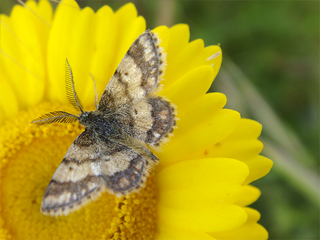
Cleta is a genus of moth in the family Geometridae.
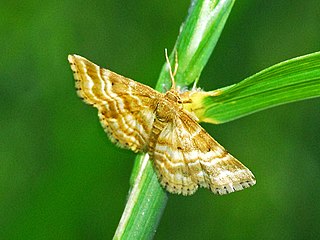
Emmiltis is a monotypic moth genus in the family Geometridae. Its only species is Emmiltis pygmaearia. Both the genus and species were first described by Jacob Hübner, the genus in 1825 and the species in 1809.

Epilobophora is a genus of moths in the family Geometridae first described by Inoue in 1943.
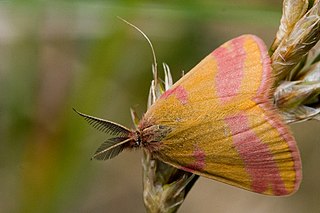
Lythria is a genus of moths in the family Geometridae erected by Jacob Hübner in 1823. It is the only genus of the monotypic tribe Lythriini described by Claude Herbulot in 1962.

Scopula rubiginata, the tawny wave, is a moth of the family Geometridae. The species was first described by Johann Siegfried Hufnagel in 1767.

Chersotis cuprea is a moth of the family Noctuidae.

Sterrhinae is a large subfamily of geometer moths with some 3,000 described species, with more than half belonging to the taxonomically difficult, very diverse genera, Idaea and Scopula. This subfamily was described by Edward Meyrick in 1892. They are the most diverse in the tropics with the number of species decreasing with increasing latitude and elevation.

Scopulini is a tribe of the geometer moth family (Geometridae), with about 900 species in seven genera. The tribe was described by Philogène Auguste Joseph Duponchel in 1845.
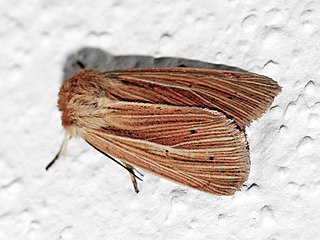
Mythimna congrua is a species of moth of the family Noctuidae.

Idaea flaveolaria is a moth of the family Geometridae first described by Jacob Hübner in 1809.
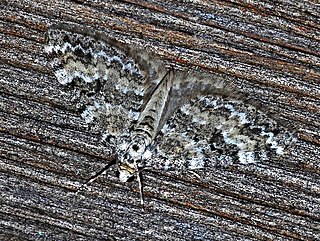
Perizoma minorata, the heath rivulet, is a moth of the family Geometridae. The species was first described by Georg Friedrich Treitschke in 1828.
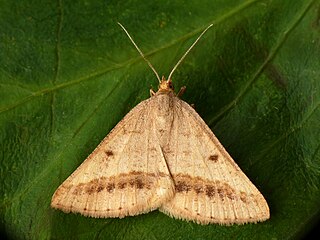
Isturgia arenacearia, the sand bordered bloom, is a moth of the family Geometridae. It was first described by Michael Denis and Ignaz Schiffermüller in 1775.

Catarhoe basochesiata is a moth of the family Geometridae. It is found in Europe. It was first described by Philogène Duponchel in 1831 as Cidaria basochesiata. Catarhoe basochesiata has a wingspan of 23–27 mm (0.91–1.06 in). The forewings vary in colour from reddish brown to greyish brown, with some moths having very dark brown forewings that poorly contrast with the patterns on them. The moth can be found across the western Mediterranean, from the Iberian Peninsula across France and into Italy and from Morocco to Tunisia. The moth prefers hot, dry conditions in low coastal regions, from 0–500 m (0–1,640 ft) above sea level and occasionally higher.

Entephria infidaria is a moth of the family Geometridae.



















